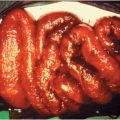Appearance of new pulmonary infiltrates after 5 or more days in hospital with:
|
a Definition does not include positive respiratory secretion cultures in ventilated patients.
Positive blood cultures (excluding blood culture skin contaminants, e.g., methicillin-sensitive Staphylococcus aureus [MSSA], methicillin-resistant S. aureus [MRSA]) or
secondary to extrapulmonary infections, e.g., central venous catheter infection, P. aeruginosa, K. pneumoniae, Enterobacter spp., Acinetobacter baumannii.
b See Table 33.2 (Mimics of nosocomial pneumonia).
In this chapter, the term NP is used rather than designation of the clinically meaningless healthcare-associated pneumonia (HCAP). Nursing home-acquired pneumonias (NHAP) are not the same as NP. First, the pathogens differ. NHAP pathogens are the same as CAP pathogens, e.g., S. pneumoniae, Haemophilus influenzae. Even though the respiratory secretion and urine/feces of nursing home/chronic care facility residents may be colonized by “hospital organisms,” e.g., GNB, these organisms are not NHAP pathogens, i.e., they do not cause NHAP. Pathogens aside, the NHAP mean length of stay (LOS) is ~ 7 days, which is the same LOS (~ 7 days) as for hospitalized CAP. This is in marked contrast to the NP LOS (~ 14 days). For these reasons, it is clinically important to differentiate NHAP from NP and not combine them as HCAP.
Mimics of nosocomial pneumonia
Because the definition of NP is based on epidemiologic rather than pathologic criteria, there are many noninfectious disorders that fit the epidemiologic definition of NP. In intensive care unit (ICU) patients, there are many mimics of NP with fever, leukocytosis, hypoxemia, and pulmonary infiltrates on chest x-ray (CXR). Many of these mimics of NP have pulmonary infiltrates but are disorders unassociated with fever/leukocytosis. In such patients with mimics of NP, the fever/leukocytosis are due to unrelated extrapulmonary processes, e.g., drug fever, phlebitis, cerebrovascular accidents, myocardial infarction, gastrointestinal bleed, adrenal insufficiency. Patients with acute respiratory distress syndrome (ARDS) often have fever/leukocytosis, hypoxemia, and pulmonary infiltrates that are unrelated to NP but rather are due to drug-induced pancreatitis mimicking NP. Other mimics of NP may have fever. In such cases, the diagnosis is usually suggested by associated extrapulmonary signs/symptoms, e.g., systemic lupus erythematosis (SLE) with pneumonitis. Before fever, leukocytosis, hypoxemia, and pulmonary infiltrates are ascribed to NP, the clinician should carefully rule out the many mimics of NP based on nonpulmonary findings from the history, physical examination, and relevant laboratory tests (Table 33.2). In ventilated patients, mimics of NP may also have positive respiratory secretion cultures. All too often, the clinical diagnosis of NP is based on “guilt by association,” e.g., fever/leukocytosis, hypoxemia, infiltrates on CXR, and positive respiratory secretion cultures.
| Fever plus leukocytosis plus CXR infiltrates plus positive respiratory secretion cultures ≠ NP | |
|---|---|
| |
NP = nosocomial pneumonia; SLE = systemic lupus erythematosus; LVF = left ventricular failure; CHF = congestive heart failure.
a The disorders listed may mimic NP and many are afebrile disorders and may be associated with leukocytosis/left shift. Fever may be present with disorders listed, not typically afebrile infection, but search should prompt for a nonpulmonary cause of the fever. ARDS is in the ICU and commonly due to acute pancreatitis (drug induced) and the patient is febrile secondary to pancreatitis not ARDS.
Diagnosis of NP should not be based on “guilt by association.”
Similarly, positive respiratory secretion’s culture should be considered as colonization, not NP, until proven otherwise. Other clues to the clinical nonsignificance of positive respiratory secretion cultures are growth of non-NP pathogens, Stenotrophomonas maltophilia, Burkholderia cepacia, or colonizing pathogens, e.g., Enterobacter spp., S. aureus, Citrobacter spp., or multiple organisms, pathogens that are significant only if in a cluster/outbreak, e.g., Acinetobacter spp.
Since a definitive diagnosis of NP is problematic, i.e., lung biopsy, some degree of overtreatment is unavoidable. If mimics of NP are excluded and the presumed diagnosis is NP, empiric monotherapy should be directed against the most important NP pathogens, e.g., P. aeruginosa, and not based on respiratory secretion cultures.
Respiratory secretion colonization versus infection
In intubated patients, respiratory secretions rapidly become colonized by nosocomial GNB. Nosocomial GNB colonization in the ICU occurs as a function of time. Antimicrobial therapy, if not chosen carefully, may not only promote colonization of respiratory secretions with GNB, but also colonization with Staphylococcus aureus, i.e., methicillin-sensitive S. aureus (MSSA) or methicillin-resistant S. aureus (MRSA). The common GNB colonizers of respiratory secretions, e.g., Enterobacter spp., Citrobacter freundii, Burkholderia cepacia, Stenotrophomonas maltophilia, are relatively avirulent and rarely, if ever, cause NP. Until proven otherwise, if these organisms are cultured from respiratory secretions of ventilated patients they should be considered as “colonizers” and not treated with antibiotics (Table 33.1). Respiratory secretions of ventilated patients are also commonly colonized by bona fide NP pathogens, e.g., P. aeruginosa, K. pneumoniae, Serratia marcescens. In contrast, Acinetobacter baumannii is a common colonizer of respiratory secretions, but is rarely a cause of sporadic NP. Unless part of an outbreak/cluster, respiratory secretion cultures positive for A. baumannii should be regarded as colonization and the cause of NP until proven otherwise. Similarly, nosocomial Legionnaires’ disease occurs in clusters/outbreaks and only rarely occurs as sporadic NP. Gram-positive cocci, e.g., enterococci, or S. aureus (either MSSA/MRSA), are common colonizers of respiratory secretions of ventilated patients receiving certain broad-spectrum antibiotics, e.g., ciprofloxacin, imipenem, ceftazidime. However, group D streptococci rarely, if ever, cause NP. In intubated patients with presumed NP organisms cultured from respiratory secretion are often considered a cause of NP and are covered/treated. There is little/no relationship between respiratory secretion cultures and distal lung parenchymal NP pathogens. The clinical and pathologic features of S. aureus (MSSA/MRSA) CAP have well-described clinical parameters to evaluate potential MSSA/MRSA NP. S. aureus (MSSA/MRSA) CAP (virtually always associated with influenza or influenza-like illness) patients are critically ill, cyanotic, and have a fulminant necrotizing/hemorrhagic pneumonia with rapid cavitation in < 72 hours (like P. aeruginosa
Stay updated, free articles. Join our Telegram channel

Full access? Get Clinical Tree





